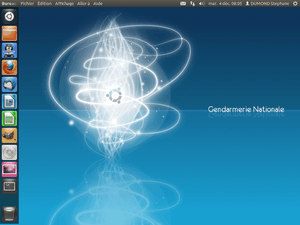GendBuntu
 | |
| Developer | French Gendarmerie |
|---|---|
| OS family | Unix-like |
| Working state | Current |
| Source model | Open source and proprietary software |
| Initial release | 2008 |
| Latest release | 12.04 LTS / December 2012 |
| Available in | French |
| Package manager | APT |
| Kernel type | Monolithic (Linux) |
| Default user interface | Unity (user interface) |
| License | Various free software licenses, plus proprietary |
| Official website |
www |
GendBuntu is a version of Ubuntu adapted for use by France's National Gendarmerie. The Gendarmerie pioneered the use of open source software on servers and personal computers since 2001 when it adopted the OpenOffice.org office suite, making the OpenDocument .odf format its nationwide standard.
Project
The GendBuntu project originated with the end of distribution by Microsoft of Windows XP, and its inevitable replacement with Windows Vista or a later edition of Windows on government computers. This meant that the Gendarmerie would have incurred large expenses for staff retraining even if it had continued to use proprietary software.
One of the main aims of the GendBuntu project was for the organisation to become independent from proprietary software distributors and editors, and achieve significant savings in software costs (estimated to be around two million euros per year).
Around 90% of the 10,000 computers purchased by the Gendarmerie per year are bought without an operating system, and have GendBuntu installed by the Gendarmerie's technical department. This has become one of the major incentives of the scheme for staff; transferring to GendBuntu from a proprietary system means the staff member receives a new computer with a widescreen monitor.
The main goal is to migrate 75,000 computers by the end of 2014, a date which coincides with the end of support for Microsoft Windows XP. 35,000 GendBuntu desktops and laptops have been deployed as of November 2011.
A major technical problem encountered during the development of the project was keeping the existing computer system online while the update took place, not only in metropolitan France but also in overseas Departments and Regions. It was solved partly by redistributing dedicated servers or workstations on Local Area Networks (depending on the number of employees working on each LAN) and with the use of an ITIL-compliant qualifying process.
An extensive IT support team helped to implement the changes. This included the "core team" at Gendarmerie headquarters at Issy-les-Moulineaux, the "running team" of four located at the Gendarmerie data center at Rosny-sous-Bois, and about 1,200 local support staff.
Timeline
- 2004 - OpenOffice.org software replaces 20,000 copies of the Microsoft Office suite on Gendarmerie computers, with the transfer of all 90,000 office suites being completed in 2005. [1]
- 2006 - Migration begins to the Mozilla Firefox web browser, on 70,000 workstations, and to the Mozilla Thunderbird email client. The Gendarmerie follows the example of the Ministry of Culture in this decision. Other software follows, such as GIMP.
- 2008 - The decision is made to migrate to Ubuntu on 90% of the Gendarmerie's computers by 2016. Ubuntu is installed on 5,000 workstations installed all over the country (one on each police station's LAN), primarily for training purposes.[2]
- 2009 - Nagios supervision begins
- 2010 - 20,000 computers ordered without a pre-installed operating system
- January 2011 - Beginning of the large scale phasing in of GendBuntu 10.04 LTS
- December 2011 - 25,000 computers deployed with GendBuntu 10.04 LTS
- February 2013 - Upgrade from GendBuntu 10.04 LTS to GendBuntu 12.04 LTS. The local management and IT support teams will phase in the upgrade in such a way to not disrupt the running of the police stations.
- May 2013 - Target for end of the migration to GendBuntu 12.04 LTS - 35,000 computers upgraded.
- December 2013 - 43,000 computers deployed with GendBuntu 12.04 LTS. TCO lowered by 40%. [3][4]
- February 2014 - Beginning of final stage of the migration of existing Windows XP computers to GendBuntu 12.04 LTS
- June 2014 - Migration completed. 65,000 computers deployed with GendBuntu 12.04 LTS (total amount of computers : 77,000)[5]
See also
- LiMux - a similar project of the city council of Munich
- Kilyn - a similar project used by People's Liberation Army in China.
References
- ↑ www
.zdnet .fr /actualites /la-gendarmerie-nationale-passe-a-openoffice-39203431 .htm - ↑ joinup
.ec .europa .eu /sites /default /files /cc /c5 /8d /IDABC .OSOR .casestudy .Gendarmerie .10 .pdf - ↑ joinup
.ec .europa .eu /community /osor /news /french-gendarmerie-open-source-desktop-lowers-tco-40 - ↑ www
.zdnet .com /it-was-a-huge-risk-how-the-end-of-xp-support-helped-frances-gendarmes-embrace-ubuntu-fast-7000022030 / - ↑ Gijs Hillenius (16 June 2014). "'Open standards and ITIL lead to open source', France's Gendarmerie tells Korean ICT ministry".
The police force now has 65,000 PC workstations running Ubuntu Linux (version 12.04).
External links
- Official website
- www
.ubuntu .com /products /casestudies /french-national-police-force-saves-2-million-year-ubuntu
| ||||||||||